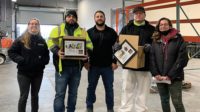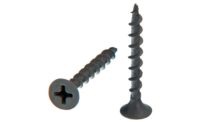The process of mudding drywall seams–which requires multiple applications of joint compound, followed by multiple drying and sanding cycles–has remained unchanged for decades. That all changed in June, when construction robotics company Canvas demonstrated its drywall finishing machine’s new feature, Level 4 Targeted Spray, at a big launch event inside its San Francisco headquarters.
The event attracted 200+ participants–including general contractors, self-perform general contractors, drywall contractors, project developers and owners, architects, union leaders and the trade media–all curious about Canvas’ announcement that it was going to reveal Level 4 Targeted Spray, its new drywall finishing system that reduces cycle times by up to 40 percent.
How does Level 4 Targeted Spray Work?
The traditional Level 4 drywall finishing process involves 7 steps prior to the sanding phase:
- Tape
- Box Coat
- Dry Cycle
- Topping Coat
- Dry Cycle
- Third Coat
- Dry Cycle
Canvas’ Level 4 Targeted Spray process involves only three steps prior to the sanding phase:
- Tape (no dry cycle required)
- Spray
- Dry Cycle
Nevell Group Inc.–one of the first drywall contractors to sign a multi-year, multi-machine lease with Canvas–worked closely with the company as an Innovation Partner to develop the Level 4 Targeted Spray feature.
“At Nevell Group, we’re always exploring new ways to be better, not only as a business and an employer, but through the services we provide as an industry leader,” said NGi CEO Chris Taylor. “A big part of our culture is to promote, nurture and champion new ideas that show the potential to help elevate our evolving industry.”
NGi recently completed the Level 5 drywall scope on the 119,000-square-foot, $174 million Sunnyvale Civic Center Modernization Phase I project for Hensel Phelps Construction using a Canvas machine with a Canvas-trained Nevell employee.
“The quality of finish that this machine produces is outstanding,” said Hensel Phelps Project Manager Andrew Cameron. “We had piloted with the Canvas team at the San Francisco International Airport Harvey Milk Terminal 1 project several years ago when they were still a subcontractor, and we were blown away by both the simplicity of the process and the quality of the finish. The machine elevates the level of consistency while also making the process more predictable.”
With demand for its machines high, Canvas recently expanded into Southern California and the Midwest. Pacific Systems Interiors, based in Los Angeles, is Canvas’ first SoCal customer. “When we heard about the Canvas machine, we had to see it in action for ourselves,” said PSI Sr. Vice President Dino Romero. “We flew to San Francisco for a live demo, and we saw the future potential in Canvas. The robot is safe, easy to operate and produces a consistent, high-quality finish. We signed a contract weeks later.”
Romero, whose company in the past 60+ years has completed half a billion dollars’ worth of work for an increasingly complex client base, attributes PSI’s success to its extremely well-trained workforce, lean construction practices and proactive focus on technology. “We were early adopters of BIM and augmented reality to make the work more accurate and increase efficiency,” he said. “We now are proud to say that PSI is an early adopter of construction robotics. We believe Canvas is the key to revolutionizing wall systems. It’s pretty amazing right now, and Canvas is working on ways to make it even more useful for our teams and our projects.”
Romero says his teams will be using Canvas Level 4 Targeted Spray on a number of upcoming projects, including PSI’s Ocean + Cherry project in Long Beach, California.
“There are any number of issues facing contractors these days, including diminishing ROI on jobs due to increased labor and material costs, as well as supply chain issues,” Taylor added. “It’s a no-brainer in this environment to make jobs as efficient as possible, which means deploying Canvas’ Level 4 Targeted Spray on every job where that makes sense. It saves time. It saves money. It’s safer and it’s more predictable. It’s that simple.”






